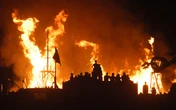Spin has its limitations. Lots of people can easily detect the stink of bad news lingering just beneath the potpourri of spin that suggests the news is actually not so bad. What works even better than spin at deflecting criticism, however, is never letting bad news get out in the first place.
Donald Trump understands this concept all too well. Over the past few months, he’s repeatedly fired government officials just for releasing, in the routine course of their duties, information that’s unflattering to his administration. The idea seems to be that these firings both cast doubt on the competence of those delivering the bad news, and instill fear in others who might uncover more in the future. Unfortunately for Trump’s 340 million constituents, though, several organizations have already used this same strategy in the private sector and ended up failing spectacularly.
Long before he was president, Trump put a high premium on keeping a team of Yes Men in tow. “I value loyalty above everything else,” he wrote in his 2007 tome, Think BIG and Kick Ass in Business and Life. “More than brains, more than drive and more than energy.”
That mindset appears to have persisted into his second presidential term. Earlier this year, Trump screened White House job seekers and Department of Justice lawyers for loyalty, and stocked his staff with sycophants. It’s not unusual these days for Cabinet meetings to function as a marathon of presidential toasts that sound somewhere between a paternal eulogy and the most reverential kind of gospel song. Being flanked by flunkies at all times, though, has apparently not streamlined the national narrative enough. This administration has lately gone a step further and sidelined anyone in a government role who presents data that contradicts the president.
Removing reality from the ranks
The first to go was acting chair of the National Intelligence Council, Michael Collins, along with vice chair Maria Langan-Riekhof. Together, they had overseen an intelligence assessment in May that ran counter to Trump’s claims that the gang Tren de Aragua was operating in “close alignment” with the Venezuelan government. (Trump had used that claim earlier to justify deporting suspected Tren de Aragua members from the U.S. without due process.) After removing both experienced career officials from their duties, Director of National Intelligence Tulsi Gabbard went on to fill Collins’s role with a vocal Trump supporter and “deep state” critic.
Next, Trump fired Erika McEntarfer, the Senate-confirmed head of the Bureau of Labor Statistics, after she delivered a July jobs report that was not to the president’s liking. In the report, McEntarfer revised down the surprisingly robust labor statistics for the first two months following Trump’s “Liberation Day” tariff bonanza back in April, and calculated dismal numbers for July as well. This dataset apparently conflicted too much with Trump’s perception of the U.S. labor market this summer, and he intervened directly. If those offending numbers end up revised in the opposite direction next month, Trump will have his as-yet-unconfirmed replacement for leading BLS, Heritage Foundation economist E.J. Antoni, to thank for it.
Now the purges are ramping up. Just this past week, on August 22, U.S. Defense Secretary Pete Hegseth fired Lieutenant General Jeffrey Kruse from his role as head of the Defense Intelligence Agency. Kruse’s only transgression appears to be his agency’s assessment of the damage a U.S. military strike inflicted on three of Iran’s nuclear facilities back in June. Trump had previously stated, over and over, that the sites had been “obliterated,” and the DIA’s report undermined the president’s claims—something verboten in Trump’s orbit. The agency’s leader clearly had to go.
Finally, on Tuesday, August 26, the Federal Emergency Management Agency suspended “around 30” of the 36 employees who signed their names to a letter delivered to Congress the previous day warning that the administration’s budget cuts had reduced the agency to pre-Hurricane Katrina levels of disaster readiness.
These likely won’t be the last bearers of bad—or even just factual—news to be punished by this administration. If history is any indication, though, these purges will harm Trump (and, let’s face it, the rest of us) in the long run. All organizations need at least a modicum of brutal honesty within their ranks to counterbalance the enthusiasm and optimism of true believers. Although the stakes of the U.S. government are obviously much higher than those of any corporation, Trump could learn a lot from businesses that made a similar practice of axing in-house truth-tellers in the recent past.
Enron
The Enron scandal is one of the most notorious instances of corporate fraud in the 21st century. The company’s top executives deliberately manipulated financial data, which led, ultimately, to Enron’s collapse into bankruptcy and wiped out billions in employee pensions and investor funds in the process. Before it all fell apart, founder Kenneth Lay and CEO Jeffrey Skilling were able to inflate their profits and hide their massive debt only by sidelining internal whistleblowers.
Then-vice president Sherron Watkins, for instance, was moved off the executive floor and given diminished duties after circulating a memo warning that Enron could “implode in a wave of accounting scandals,” while in-house risk assessment expert Vincent Kaminski’s team was transferred to a different department and told that in urging against shady practices they had acted “like cops.” Perhaps it takes a team within an organization acting like cops, though, to help avoid incurring a visit from actual cops.
Theranos
In the 2010s, Elizabeth Holmes cultivated Steve Jobs comparisons by saying she’d developed a miracle device that conducted instant blood tests from miniscule samples. Her company, Theranos, was valued at $9 billion at its peak. The only problem? The device barely existed. In a doomed quest to hide that fact from outside eyes, or buy time until the team could figure out some kind of Hail Mary fix, top brass at Theranos pushed back on dissenters.
According to research engineer Tyler Shultz, company leaders, including Holmes and her deputy, Ramesh “Sunny” Balwani, “aggressively dismissed internal warnings.” Employees like Shultz and lab worker Erika Cheung faced harassment for raising concerns, prompting them to quit the company and leak details to the press. As it turns out, while upper management may not always be receptive to internal warnings, reporters often will be.
Boeing
The world’s largest aerospace company kicked off 2024 with a terrifying midair malfunction on an Alaska Airlines flight, and ended the year with a jet crash disaster in South Korea. Both incidents followed a pair of deadly crashes of Boeing 737 Max planes in 2018 and 2019. As a result of all the chaos, Boeing became the subject of a June 2024 Senate hearing about the company’s “broken safety culture.” During the hearing, now-former CEO Dave Calhoun admitted that Boeing had previously retaliated against employees who came forward with safety concerns. Many aggrieved whistleblowers have also attested to that fact.
John Barnett, for instance, a former quality control manager at Boeing, reportedly shared his safety concerns with supervisors, who responded by “ignoring him and then harassing him.” (Prior to his death by suicide in 2024, Barnett had been suing the company for “retaliation.”) Quality engineer Sam Salehpour meanwhile claimed last year that he’d repeatedly raised concerns about alleged manufacturing shortcuts at Boeing starting in 2020 only to be told “to shut up”; he then transferred to a different role. Several other employees have similar stories. As a result, Boeing’s reputation has taken a massive hit.
Whenever it comes out that an organization retaliated against objection-raisers on the path to avoidable catastrophe, that organization comes off as desperate, vindictive, and dishonest; not merely unmoored from reality, but actively opposed to it. The U.S. government is currently operating as exactly this kind of organization. And just like in those other examples, it will eventually become public knowledge that catastrophe was avoidable—but only after it’s already happened.









No comments